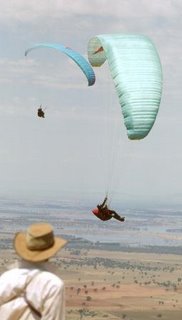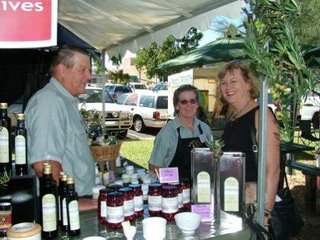Every New England family has its own Christmas rituals.
To most young, at least those lucky enough to live in stable middle class families, these seem unchanging. It is only looking back that we can see how quickly things change.
As children brother David and I had a fixed and very satisfying Christmas ritual.
Christmas Eve was open house at our place for mum and dad's friends and their children.
Planning began days in advance. A suitable pine tree branch was obtained, put in an old iron pot and surrounded by packed down dirt. Mum got out the Christmas decorations from the top
cupboard of the linen closet to decorate the tree and the house.
On
Christmas Eve, sometimes the day before, dad went out to Ryan's Cordials, the
Armidale soft drink maker, to get the soft drinks and mixers. Supplies of beer and spirits were obtained. The ice was broken up and put in the laundry tub or, later,
eskies.
Mum got out the special punch jug and supporting glasses, pretty glassware only used at this time of the year. She then made her special and famous punch and then the sandwiches, especially cucumber and tomato.
People started arriving about 7pm. The
Buzos, the
Halpins, the
Harrises, the Foxes and so on. We were allowed to help and played with the other kids. Then after people left, we tidied up and finished off the last of the cucumber sandwiches.
Christmas morning David and I woke early to see what Santa had brought us. In our case, Santa filled a pillow case (none of those small stockings!) that was left on the end of our bed. There were lollies, books and loads and loads of small toys. Even today, my own children insist on the pillow case, although this year for the first time they are actually Christmas stockings.
Once or parents woke - usually with a bit of prodding - it was time for present exchange. Then David and I settled down to play and read.
Mid morning it was off to
Fah and Gran's.
Mann Street - we always called it Mann Street to distinguish it from Marsh Street, our house - was a children's paradise.
The house was a large one, located on a very large block. Originally built to face the north, the front of the house with its front steps dropping to the garden was in fact the back, the back the front.
Tall pine trees ran along the front and back fences, creating a paradise for children who liked to climb. I still remember the excitement when heavy snow caused branches on the trees at the front (always the better climbing trees) to crash to the street.
Looking at the house from the street the more formal gardens faced the street. There were small single car garages to the left and the right whose
rooves could be reached by nearby trees, creating vantage points for kids playing hide and seek; home was always one of the big cement pedestals marking the end of the stairs at the other end of the house.
Facing from the street, gardens ran to the left and right of the house.
On the left, the flatter side, there was a gravel path near the house then a row of shrubs and gardens, a stretch of grass then a hedge. This was the side of the house we could break into as kids because the house was lower to the ground, allowing us to climb up the foundations.
On the left, a lawn sloped down to a gravel path (we loved rolling head over heels down this lawn) and then the garden shed. This provided another vantage point for our games of hide and seek.
At the front (back), the house was high from the ground with a
veranda facing the north. There were in fact
verandas on the south, east and north of the house. The
verandas on the west of the house had been closed in.
On the high
veranda at the front there were chairs for people to sit and watch the rest of the garden including especially the tennis court. It was here sometimes that I used to sit with
Fah in the morning eating my porridge in the weak morning sun. Proud of his Scottish ancestry, he ate porridge with cream and salt, not sugar. I did the same.
From the
veranda there was a short
stretch of down sloping land, mainly lawn, to another hedge and then a fence marking the dividing line to the back garden. On the left was the
kitchen garden, then the tennis court and a stretch of rough grass where the cow grazed when we were very young. At the back of the tennis court was a small byre for the cow, more rough grass.
Back to Christmas. Upon arrival at Mann Street we exchanged presents with
Fah and Gran and my aunts. This was followed by open house for my grandparent's friends and campaign workers. At the time I was born,
Fah had already been a local Member of Parliament for twenty five years, so there was a constant stream of people.
Then lunch, usually a chicken from the birds my grandparent's kept, with all the trimmings. The
Mackellars, Mr
Mackellar managed
Fah's property outside
Armidale, always came in for Christmas with the family. At lunch we kids always ate separately from the adults in a small sun room off the dining room, separate but still in seeing and hearing distance.
We played in the afternoon while the adults talked. I remember one year a piper came in (
Fah was very proud of his Scottish ancestry) and we all gathered on the
veranda while the piper strode the lawns below.
Then back home for a rest. In the late afternoon we always went up to the
Halpins for a drink.
Vee and Bruce had been very long standing friends of Mum and Dad, while brother David and I were close friends with the
Halpin twins.
Finally, home for a meal of left overs.
Time passes, things change.
Fah sells the property and the
Mackellars move. Our aunts get married. Then Gran is killed in a car accident. My parents think about buying Mann Street but hold off because we cannot get a good enough price for our house. Then
Fah marries
Aimie, subdivides Mann Street into two falts, retiring from politics soon after. Then
Fah dies.
These are big changes. Yet they happen in a time horizon that allows for adjustment. Our Christmas evening Marsh Street opening houses continue. Kay and Margaret bring their children back to
Armidale. I form the habit of dropping into Mann Street for a drink with
Fah and
Aimie. No longer a child, I listen to
Fah's stories about his dreams, experiences and achievements.
More time passes, more things change. I join the New England diaspora taking a job in Canberra.
New England has been draining its young for a hundred years.
In the absence of self-government, it lacks the public service positions that would allow people like me to serve local interests, as well the the state branch positions found in other states. We also have few major locally headquartered businesses.
All this means that New England's most ambitious young leave. As a rough order of scale, I suspect that if we take those born in New England plus their immediate children, the number of New
Englanders outside New England is as great as those living in New England.
Now there is a new pattern. At Christmas time from Newcastle in the south to
Lismore in the north, from
Kempsey in the east through
Armidale to
Moree, thousands of New England's young return home to family for Christmas. Initially they travelled by train and especially the night mail trains, meeting friends on the train, later by car and plane.
In my case I would leave Canberra by car as soon as work finished. If there was time, I would go through Sydney to see Aunt Margaret and Uncle Jim, a new ritual, arriving where possible at
Armidale in time for mum and dad's Christmas eve open house. However, sometimes I did not arrive in
Armidale until 5am on Christmas morning.
Christmas now was a time for catching up with old friends, including especialy those living elsewhere. We talked, played tennis or sometimes golf, visited the pub. Then it was over for another year.
More time, still more changes. My parents die, then Uncle Ron, destroying part of the old rituals. There is a short gap and then I return to live in
Armidale with my own family, recreating the old pattern although we do spend some Christmases in Sydney with my wife's family.
As with David and I, Santa leaves presents in a pillow case on the end of the bed. There is then the excitement as the kids wake up early to see what Santa has brought them. Over breakfast we open presents to each other. Then at either lunch or dinner time it is usually off to Aunt Kay's for the main Christmas meal.
Merinda Place, Kay's home, now plays the role that used to be played by Mann Street as the aunts and often their children gather. There are now far fewer returning
expatriats of my generation as their parents retire away from
Armidale or die, but it is still all reassuringly familiar.
Still more time passes, still more changes.
Time periods are shortening now. After eight years in
Armidale we move to Sydney so that my wife can pursue a new career, but still we mainly return to
Armidale for Christmas with Kay and my other aunts. My daughters are older, but there is still all the excitement of going back, of seeing Kay and the other family.
Then one by one my aunts die including Kay. With no immediate family left in
Armidale, with no family home, Christmas is now largely spent in Sydney with my wife's family. There is still the excitement especially for Helen and Clare, some things are still the same, but I do miss the old rituals and the people that formed such an important part of my life for so long.
I hope that all this does not sound too morbid. It's just that Christmas itself is a time for looking back, for remembering blessings granted. As we used to say in a Christmas toast, to absent friends.
I hope that you and yours have a very happy Christmas and a great new year.

 Photo: Hunter Valley Vineyards.
Photo: Hunter Valley Vineyards.  Photo: Passengers New England Airways, New England's first major airline. Hood Collection.
Photo: Passengers New England Airways, New England's first major airline. Hood Collection. 


























